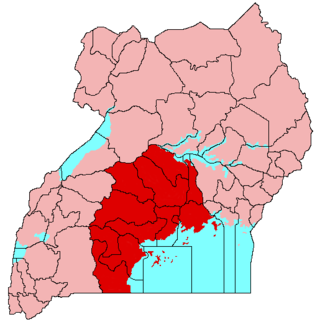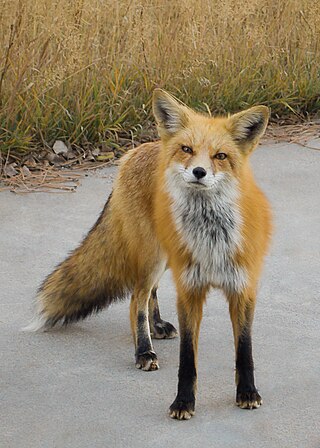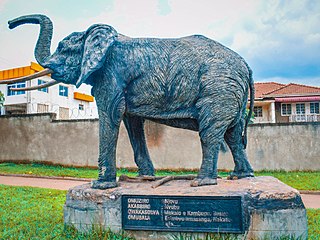
Buganda is a Bantu kingdom within Uganda. The kingdom of the Baganda people, Buganda is the largest of the traditional kingdoms in present-day East Africa, consisting of Uganda's Central Region, including the Ugandan capital Kampala. The 14 million Baganda make up the largest Ugandan region, representing approximately 16% of Uganda's population.
Jjunju Sendegeya was Kabaka of the Kingdom of Buganda from 1780 until 1797. He was the twenty-sixth (26th) Kabaka of Buganda.
Mpindi is one of the 56 clans of the Buganda Kingdom, one of the largest nations of Uganda. The Mpindi chief is Mazige, whose headquarters are located in Muyenje in Busiro County in Uganda. The Mpindi clan has the mpindi, a Luganda word for cowpea, as its totem.
Mwanga I was Kabaka of the Kingdom of Buganda from 1740 until 1741. He was the twenty third (23rd) Kabaka of Buganda.
Tebandeke Mujambula, sometimes spelled as Ttebandeke Mujambula, was Kabaka of the Kingdom of Buganda between 1704 and 1724. He was the 18th Kabaka (king) of Buganda.
Mawanda was Kabaka (King) of the Kingdom of Buganda, between 1738 and 1740. He was the twenty second (22nd) Kabaka of Buganda.
Semakookiro, also spelled as Ssemakookiro, whose full name is Semakookiro Wasajja Nabbunga, was Kabaka of the Kingdom of Buganda, from 1797 until 1814. He was the twenty-seventh (27th) Kabaka of Buganda.
Kamaanya Kadduwamala was Kabaka of the Kingdom of Buganda from 1814 until 1832. He was the twenty-eighth (28th) Kabaka of Buganda.

The Baganda also called Waganda, are a Bantu ethnic group native to Buganda, a subnational kingdom within Uganda. Traditionally composed of 52 clans, the Baganda are the largest people of the Bantu ethnic group in Uganda, comprising 16.5 percent of the population at the time of the 2014 census.
Wasswa Chwamale Mwanga Winyi was a reigning monarch of Bunyoro-Kitara during the period circa 1300 AD. His chief palace was located at Kibulala, Ssingo, where his remains are buried today. When Prince Kalemeera of Buganda, the only son of Ssekabaka Chwa Nabakka, was exiled to Bunyoro, he took refuge at the palace of his paternal uncle, Winyi I at his palace in Kibulala. There he committed more transgressions, fathering Prince Kimera Walusimbi with Lady Wannyana, his uncle's chief wife. Prince Kimera later became the third Kabaka of Buganda.
Katikkiro is the official title of the head of cabinet and government in Buganda under the Kabaka of the Kingdom of Buganda. He is the equivalent of a Prime Minister is some governments but the Katikkiro does not assume office through elections like in other countries. His authority is symbolized by the Ddamula stick which is given to him by the Kabaka as a tool to 'kulamula' in the kingdom on his behalf. Buganda is a traditional kingdom in modern-day Uganda located in the central region of the East African country. The current Katikkiro is Mr. Charles Peter Mayiga of the Mutima clan and was appointed by the current monarch, the Kabaka of Buganda, Muwenda Mutebi II of Buganda in May 2013, replacing Engineer John Baptist Walusimbi.
The Basimba are a Bantu-speaking community in Uganda. The name Basimba is a label of shared identity that predates the 13th century. Basimba has been alternatively associated with the people or their place of origin. The early Ovambo people applied the name to the whole group of the leopard totem clan, known as Bena Ngo in Zambia and Abe Ngo in Uganda.

Mpologoma clan is among the clans in present-day Uganda that are believed to have come with Kintu. Mpologoma is a name in Luganda which means lion. Everyone belonging to the Buganda Kingdom belong to a clan, each having a totem whereas others have minor totems which they are not allowed to eat and these totems are guarded jealously. The King of Buganda is also known as "Mpologoma ya Buganda" which means the "lion of Buganda".

The Nvuma clan is believed to be one of the clans that were formed under Kabaka Kato Kintu. It is among the clans in Buganda Kingdom. Nvuma is a name in Luganda which means Pearl.

Lugave Clan is one of the many clans in Buganda Kingdom. Lugave Clan is one of the five clans that were indidgenous to Buganda Kingdom before the coming of Ssekabaka Kato Kintu. Lugave is a Luganda word meaning Pangolin. Members who belonged to the five clans are referred to as Bannansangwa who are the originals. The other Bannasangwa Clans are Fumbe, Ngeye, Njaza, and Nnyonyi Nnyange. The head of the Lugave Clan was called Mukiibi Ssebuko Ssalongo, known at the founding of the Buganda Kingdom.

Nvubu Clan is among the many clans in the present day Buganda Kingdom. It is one of the clans that came to Buganda with Kintu. Nvubu is a Luganda name meaning Hippopotamus. The Nvubu clan head is Kayita.

Ntalaganya Clan is among the many clans in the present day Buganda Kingdom. It is one of the clans that were there before the reign of King Kintu. Ntalaganya is a Luganda name which means Blue Duiker. the ancestral home of the Ntalaganya Clan is in Kiwawu (Busujju).

Kibe Clan is among the many clans in Buganda Kingdom. Kibe is a Luganda name which means fox. The Kibe Clan existed during the reign of King Kintu. The Head of the Clan is called Muyige. The Clan seat for Muyige is found at Wantaayi in Kyaggwe(Present Mukono District). The Kibe Clan people first settled in Busujju before they went to Kyaggwe(presently Mukono district).

Njovu Clan is among the many clans in the present day Buganda Kingdom. All members belonging to the Buganda Kingdom belong to a clan each having a totem. Njovu is a Luganda word meaning Elephant.The Head of the Njovu Clan is Mukalo, he also is the founding father of the Clan.

Ngeye Clan is one of the many clans of the present day Buganda Kingdom. Ngeye is a Luganda word which means Colobus Monkey. The Clan Leader is called Hajji Mohamood Minge Kasujja. One of the clans Kintu found already established in Buganda Kingdom. Bakazirwendo Ssemandwa is the grandfather of the Ngeye Clan.










